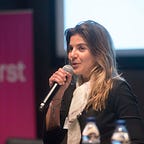Myfirstminute in conversation with three unicorn founders turned investors: Cristina Fonseca, Paul Forster & Fabrice Grinda
We caught up with Cristina Fonseca (Co-founder Talkdesk ($1bn private valuation) and Venture Partner at Indico Capital Partners), Paul Forster (Co-founder & former CEO Indeed.com — $1bn acquisition by Recruit), and Fabrice Grinda (Co-founder & Co-CEO OLX (acquired by Naspers), Zingy (exited for $80m), and Founding Partner at FJLabs).
Video recording available here
Here are our key takeaways.
- Lessons learnt from the early days: pick the right market, stay lean, and work hard
Before building Talkdesk, Cristina founded three businesses that never took off: the first one was a platform to help students prepare for exams. While the market was large enough, the willingness to pay wasn’t. The second, an Amazon SES bounce tracking tool, was too good of an idea as Amazon ended up developing its own solution. And the third was never launched because within just months into development, Cristina and her co-founder realised they faced 31 competitors. So before embarking into a new entrepreneurial idea, Cristina says: “it is crucial to pick the right market. Make sure the space is not overcrowded with competitors, that the market is large enough and that you’re able to build a competitive advantage.”
Essentially — know and assess your market. When Fabrice built Zingy in 2000, at the height of the dotcom crash when capital wasn’t available, he asked himself: “what can I build that is going to be immediately profitable? What can I execute on with limited capital?”. So he built a mobile media company, which he grew to $200 million in revenue almost bootstrapped.
Second, keep a lean mindset. “Stay disciplined on how you spend your money and on execution”, says Paul. When Paul started Indeed.com, he and his co-founder always made sure to keep a tight marketing budget ROI positive.
And third, work relentlessly. When Cristina recounts her Silicon Valley days, she says: “People in the US constantly say they’re too busy and that they work really hard. So when you hear this all the time, you start embracing it and believe that’s the way. So that’s what we did. We just worked every minute”.
2. Test your idea and try to find product market fit ASAP
Following the success of Zingy, when Fabrice started OLX in 2006 — to essentially rival Craigslit — he managed to raise $10m pre-launch on a PowerPoint only. He decided to spend $50k in 100 countries, so $5m, “throwing a lot of spaghetti on the wall to see where it stuck”. The idea was to test loads of different markets with a small budget per country before focusing on a few. Though OLX didn’t work in the US, it worked really well in Brazil, Portugal, India and Pakistan. And after winning those four markets, OLX then expanded to another thirty across emerging markets.
3. After product market fit, nail your business model
In the case of Indeed.com for instance, the high traffic they saw was a testament to the model. In 2008, while most job search engines were getting slashed by the market, Indeed kept growing, increasingly gaining market share, and ended up surpassing their #1 competitor Monster.com, becoming the highest-traffic job site in the US.
The key to their success and their main differentiator was their business model. They applied the Google model to Classifieds by putting job seekers first, giving them a comprehensive job search experience by aggregating jobs from all over the web and including them in their index for free. Second, their auction revenue model of “pay-per-click” was more powerful than the “pay-per-listing” model of their competitors (another analogy to Google’s search engine and ad words product).
When they hit the recession in 2008, the fact that the traffic on Indeed was so high and the pricing model was more flexible and cost effective than the “pay-per-listing” Job Boards’ model, enabled them to continue growing and provide their clients with a more cost effective candidate acquisition channel.
4. Stay humble and be kind to yourself
When Cristina describes her journey, she says: “We were realistic: if we saw something wasn’t working, we incorporated the lesson we were learning along the way and moved on”. Essentially:
1) Be realistic with yourself
2) Accept what you know and don’t know
3) Do something you understand
4) Pick a market that’s big enough & sees value in what you’re doing
5) Learn to let go
5. Profitability: a defining moment
For Fabrice, the most important moment as an entrepreneur was not when he exited Zingy and got $80m in the bank, but actually when he became profitable. After having missed payroll 27 times in two years, quoting him he says: “the most critical moment was the day we got that first customer check that allowed us to pay the backpay, credit card debt, and the rent. We were saved. I knew we had become the masters of our own destiny”.
6. Three tips in times of crisis
From Fabrice: “in this environment, if you’re a late stage company, you should have one KPI: get to profitability. If you’re an early stage company, you need to survive. Make sure you have 24 months of runway.”
From Paul: “try to reorient your strategy towards sectors that are still buoyant in so far as you can. Identify the sectors that are still open to weather this situation (such as healthcare).”
And finally, increase the frequency of your communication with your stakeholders and employees. In 2008, Union Square Ventures tried to buy New York Times’ stake in Indeed. They got quite a long way. But Indeed released their revised projections just before the deal closed, and USV ended up pulling out of the deal. This goes to show that frequent communication can change outcomes during these difficult times.
